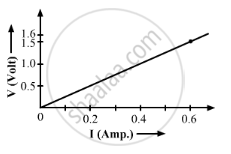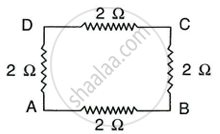Advertisements
Advertisements
Question
Which of the following represents voltage?
Options
`("Work done")/("Current" xx "Time")`
Work done × Charge
`("Work done" xx "Time")/"Current"`
Work done × Charge × Time
Solution
`("Work done")/("Current" xx "Time")`
Explanation -
Potential difference (V) is defined as the ratio of work done (W) and charge (Q).
`"V" = "W"/"Q"`
Q = i × t
Charge is defined as
Q = i × t
where i = current
t = time
So,
`"V" = "W"/("i" xx "t")`
`"Voltage" = ("Work done")/("Current" xx "Time")`
APPEARS IN
RELATED QUESTIONS
Choose the correct alternative and rewrite the following sentence.
When the resistance of a conductor increases, the current will ________ increase.
Draw the electrical symbols of the following components and state its use:
Rheostat (variable resistance)
An electric circuit consisting of a 0.5 m long nichrome wire XY, an ammeter, a voltmeter, four cells of 1.5 V each and a plug key was set up.
Following graph was plotted between V and I values:

What would be the values of `V/I` rations when the potential difference is 0.8 V, 1.2 V and 1.6 V respectively?
What conclusion do you draw from these values?
What is the resistance of the wire?
A car headlight bulb working on a 12 V car battery draws a current of 0.5 A. The resistance of the light bulb is:
(a) 0.5 Ω
(b) 6 Ω
(c) 12 Ω
(d) 24 Ω
If you were going to connect two light bulbs to one battery, would you use a series or a parallel arrangement? Why? Which arrangement takes more current form the batte
In the network shown in the following adjacent Figure, calculate the equivalent resistance between the points.
- A and B
- A and C

What is meant by internal resistance of a cell?
What is the speed of electric current?
